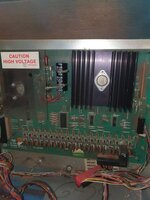Trying to work through this issue.
I want to get it fixed before pinfest as its supposed to be going there, (and @Poibug will be ****ed at me if I take it broken and and ask him to have a look when I get there!! )
)
So let's see if we can work out what's going on with it.
I'll go through in baby steps because I'm trying to improve my diagnostic skills so I can actually work out what's happening when something goes wrong, so I'll go through what I've done, if I've missed any steps or forgotten something obvious, please let me know so I can try to get better at working out what's wrong.
So, first thing is what happens. Games boots and starts flashing into attract mode but about 2 seconds later (possibly before it's finished booting to be honest ) the fuse blows.
So, after a couple of fuses I pop the circuit breaker in.
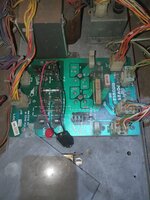
There isn't actually much happening on this board but looking at the schematic fuse f3 is only in the circuit with the bridge before it goes to 1 of the pins on J3 (the 12pin connector.)
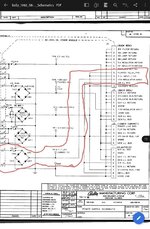
So, disconnect J3 and reboot to see if it's a problem on the board or further upstream. Turn it on and the fuse doesnt pop. Reconnect it and the fuse pops again.
So now I need to see where pin 10 is going.
Different page in the schematic shows where it's going.
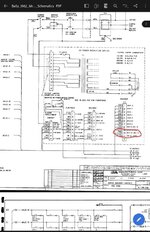
So this tells me the colour of the wire (70. 7 = Orange 0= no trace) and where it goes to: A3J3-12 and A8J1-10 (I think. I'm not sure about it going to two places to be honest. )
A8 is listed in the schematic as the talk and squawk board, I struggled to find A3 in the schematic, but eventually found it as part of the solenoid driver voltage regulator schematic.
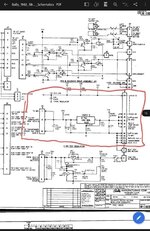
But this is where I'm getting to the limit of what to test and why I should test that thing.
I pulled the connector from this board (but left the talk and squawk board connected) and fuse didn't blow, so it looks like it is this board, but it also looks like the voltage comes in (on pin 12) and goes straight out on the same connector on pin 11) , so is it this board or the mpu to look at next?
What is the next step in working out what's wrong?
I want to get it fixed before pinfest as its supposed to be going there, (and @Poibug will be ****ed at me if I take it broken and and ask him to have a look when I get there!!
So let's see if we can work out what's going on with it.
I'll go through in baby steps because I'm trying to improve my diagnostic skills so I can actually work out what's happening when something goes wrong, so I'll go through what I've done, if I've missed any steps or forgotten something obvious, please let me know so I can try to get better at working out what's wrong.
So, first thing is what happens. Games boots and starts flashing into attract mode but about 2 seconds later (possibly before it's finished booting to be honest ) the fuse blows.
So, after a couple of fuses I pop the circuit breaker in.

There isn't actually much happening on this board but looking at the schematic fuse f3 is only in the circuit with the bridge before it goes to 1 of the pins on J3 (the 12pin connector.)

So, disconnect J3 and reboot to see if it's a problem on the board or further upstream. Turn it on and the fuse doesnt pop. Reconnect it and the fuse pops again.
So now I need to see where pin 10 is going.
Different page in the schematic shows where it's going.

So this tells me the colour of the wire (70. 7 = Orange 0= no trace) and where it goes to: A3J3-12 and A8J1-10 (I think. I'm not sure about it going to two places to be honest. )
A8 is listed in the schematic as the talk and squawk board, I struggled to find A3 in the schematic, but eventually found it as part of the solenoid driver voltage regulator schematic.

But this is where I'm getting to the limit of what to test and why I should test that thing.
I pulled the connector from this board (but left the talk and squawk board connected) and fuse didn't blow, so it looks like it is this board, but it also looks like the voltage comes in (on pin 12) and goes straight out on the same connector on pin 11) , so is it this board or the mpu to look at next?
What is the next step in working out what's wrong?

